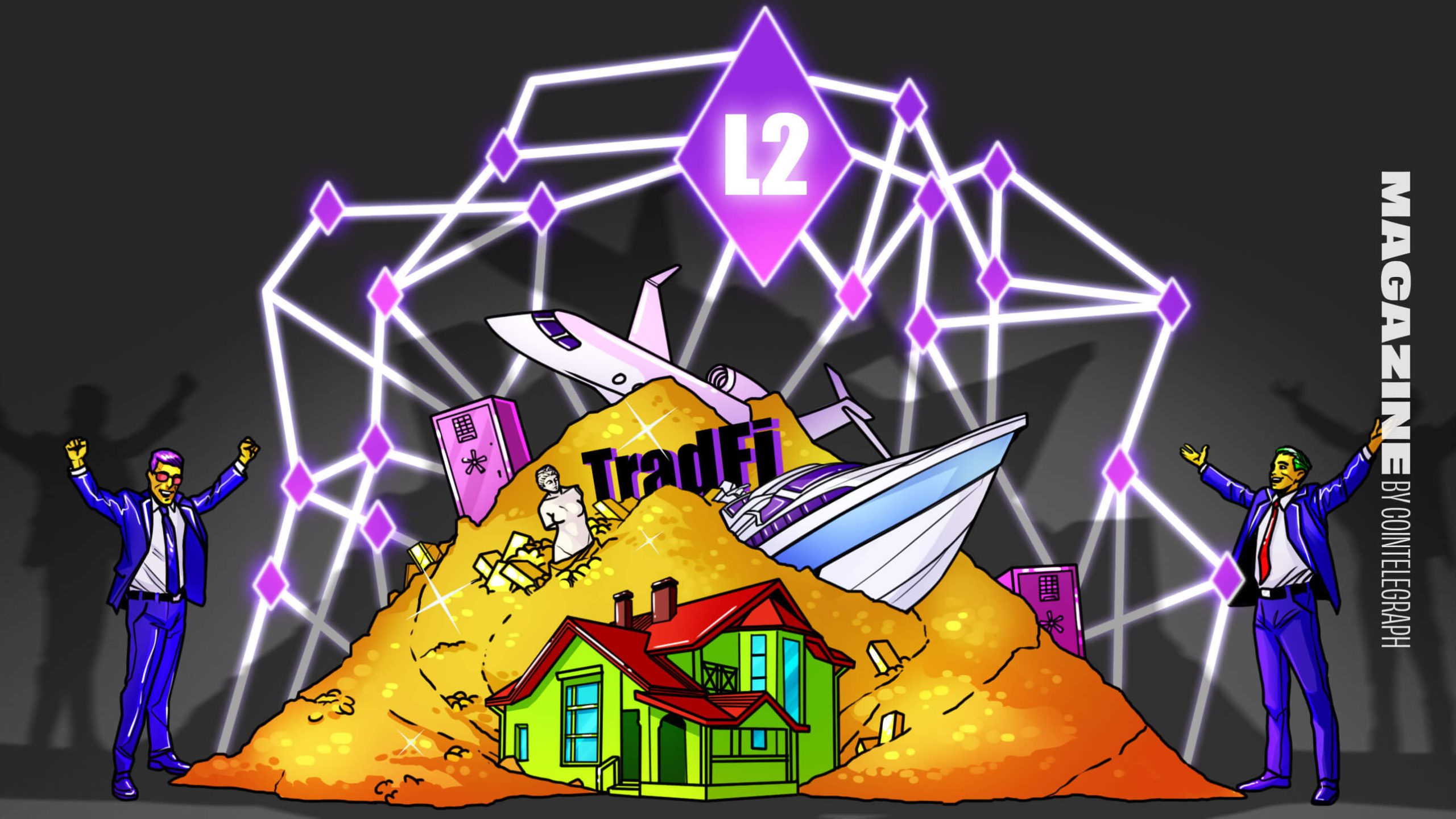After John got the balls to use a DEX, now he is adventuring on a very complicated path: Decentralized Derivatives. We must help John understand what are those and how do you use them. Please John, it might be(and it is) complicated, but I and others will try my best to make a summary using the simplest terms ever. As an explanation of what they are:
John, imagine a contract that gets its value from something else, like stocks, gold, or even interest rates. These contracts are called derivatives. People use them for different reasons: to protect themselves from price changes, to bet on where prices will go, or to increase their investments. But they're risky and need a good understanding.
In the world of decentralized finance (DeFi), there are derivative apps worth about $5.82 billion, which is 8.2% of the DeFi world. However, they face challenges because of high fees on Ethereum, so they're not as big as lending apps, which are worth $10.68 billion. (data from 2021)
Two of the major DeFi derivative apps are Synthetix and Opyn.
"Ok,so those two are the major ones. I would like to know more about Synthetix." Sure thing John, we will go slowand steady so at the end of this chat, you will be an expert on this topic. Here is the answer that I have for you:
Synthetix is like a system on Ethereum that creates fake assets called Synths. These Synths can be traded on a platform called Synthetix.Exchange. It's all about making and trading these fake assets.
"And what are those *fake assets* ?" The answer might surprise you because only the name makes them to seem complicated :
Synthetic assets, or Synths, are like special tokens that follow the value of real assets without you needing to own the actual assets. There are two types: Normal Synths, which go up when the real assets go up, and Inverse Synths, which go up when the real assets go down.
For example, Synthetic Gold (sXAU) tracks the price of gold, and Inverse Bitcoin (iBTC) goes up when Bitcoin goes down and vice versa. Inverse Synths have limits, so they can only go up or down by a certain amount. When they reach these limits, their prices are locked, and you can exchange them at those fixed values on Synthetix.Exchange. Then they start over with new limits. It's like a way to bet on the price of assets without owning them directly.
"Why Synthetic Assets?" Why are you not paying attention John :
Synthetic assets, or Synths, are handy because they let traders benefit from an asset's price movements without owning it. For example, Synthetic Gold (sXAU) lets you profit from gold's price changes without dealing with traditional gold brokers, paperwork, or middlemen.
Synths also have a cool feature: you can easily trade one Synth for another. So, if you have Synthetic Gold, you can quickly exchange it for Synthetic Japanese Yen, Synthetic Silver, or even Synthetic Bitcoin on Synthetix.Exchange. It's like having access to all kinds of real-world assets using your Ethereum wallet.
"And how are those created exactly?" Here is your answer John :
Creating Synths is kind of like making DAI on Maker (https://www.reddit.com/r/CryptoCurrency/comments/16lyksk/helping_the_average_john_guy_understand_the_defi/ here is the link if you don't remember), but with a twist. To start, you need to lock up Synthetix Network Tokens (SNX) as collateral. SNX is a bit less stable than Ethereum (ETH), so you need a bunch of it to back your Synths. We're talking at least 500% of the Synths' value as collateral, which is a lot more than the 150% needed on Maker.
For example, if you want to make $100 worth of Synthetic USD (sUSD), you'll need at least $500 worth of SNX as backup.
Making Synths can get tricky because it involves taking on some debt. The debt levels change depending on how much Synths are floating around in the system. If, for example, everyone's using synthetic Ethereum (sETH), and the price of real Ethereum doubles, the debt (including yours) doubles too.
Once you've made your Synths, you can trade them on Synthetix.Exchange or other decentralized exchanges like Uniswap. If you're not into making Synths and don't want to deal with debt, you can simply buy them from a decentralized exchange.
"Are there many assets that are supported?" Yes, quite a lot actually John :
- Cryptocurrencies: These are like digital currencies, and Synths support a bunch of them, like Ethereum, Bitcoin, Cardano, and many more.
- Commodities: Synths also track real-world stuff like Gold, Silver, and Oil. So, you can trade Synths representing these commodities without owning the actual items.
- Fiat Currencies: Synths mimic traditional money, such as USD (US Dollars), AUD (Australian Dollars), CHF (Swiss Francs), JPY (Japanese Yen), EUR (Euros), and GBP (British Pounds).
- Indexes: You can also find Synths that follow indexes, which are like collections of stocks or assets. There's one for Centralized Exchanges, another for the FTSE 100 Index, one for the Nikkei 225 Index, and even one for the DeFi Index.
- Stocks: Synths don't stop there; they also mirror individual stocks like Tesla (TSLA). So, you can trade a Synth that's linked to Tesla's stock price.
These Synths give you a way to invest in or trade these different assets without having to own them physically. It's like having a piece of various financial pies, all in one place.
"Just saw this name : Index Synths. What does it mean?" Don't get scared John :
Index Synths on Synthetix are like baskets of different tokens bundled together to represent a specific group of assets. As of April 2021, there are four main Index Synths: sCEX, sDEFI, sFTSE, and sNIKKEI.
sCEX: This Index Synth is like a mix of tokens from various centralized exchanges (CEXs). It tries to match the total value of tokens on these exchanges. It includes tokens like Binance Coin, Crypto.com, and others. There's also an "inverse" version called iCEX.
sDEFI: As the name suggests, this Index Synth gives you exposure to a bunch of tokens from the DeFi (Decentralized Finance) world. It includes tokens like Aave (https://www.reddit.com/r/CryptoCurrency/comments/16mvlcv/helping_the_average_john_guy_understand_the_defi/ Aave guide if needed) , Uniswap (https://www.reddit.com/r/CryptoCurrency/comments/16ncsjj/helping_the_average_john_guy_understand_the_defi/ Uniswap guide if needed) , Maker, and several others. Just like sCEX, it has an "inverse" counterpart called iDEFI.
sFTSE and sNIKKEI: These Index Synths follow the performance of specific stock market indexes. sFTSE tracks the FTSE 100 Index, which represents the top 100 companies listed on the London Stock Exchange. sNIKKEI follows the Nikkei 225 Index, which includes major companies from the Tokyo Stock Exchange.
By trading these Index Synths, you can get exposure to a whole group of assets without having to buy each one separately. It's like getting a piece of the action in different parts of the financial world with a single Synth.
"And this Exchange, it's the same as the others?" No, listen carefully :
Synthetix Exchange is a special kind of exchange where you can trade SNX and Synths. Unlike regular exchanges, it doesn't have order books or pools of money like Uniswap. Instead, it uses a smart contract to make sure there's always enough money for trading, which helps prevent problems like price changes when you make big trades.
Here's what's cool about it: When you trade on Synthetix Exchange, you're not actually buying the real assets; you're getting a contract that follows the value of those assets. This means you can make really big trades without causing the contract's price to change a lot. In a normal exchange, a huge trade could mess up the prices, but not here.
So, it's a different way to trade, and it's designed to be efficient and prevent problems like price changes or not having enough money to trade.
"If I want to start using it one day, can you give mesome instructions?" Sure thing John. Just follow those steps:
Step 1: First, you need SNX tokens as collateral. If you don't have them, you can get them on exchanges. In this example, I will swap ETH for SNX on Uniswap.
- Go to Uniswap (https://uniswap.exchange/swap).
- Connect your wallet.
- Enter the amount of ETH you want to swap for SNX.
Step 2: Now, you're ready to mint your Synth. Go to https://staking.synthetix.io/.
- Connect your wallet.
- Click "MINT sUSD."
Step 3: Choose "MINT MAX" or "MINT CUSTOM." For this example, I will choose "MINT MAX."
Step 4: The amount you can mint depends on the collateral ratio of SNX to the Synth. In April 2021, the ratio is 500%. So, if you have $275.55 worth of SNX, you can mint about 55.06 sUSD.
Step 5: A Metamask pop-up will appear. Click 'Confirm.' The website will show that the minting is in progress while you wait for the transaction to complete.
Step 6: After confirmation, you'll see sUSD in your wallet balance. That's it John.
"Ok, that's enough Defi for today friend. I wi-" STOP RIGHT THERE. I have not finished yet. Please take a seat John. We haven't discussed about Opyn.
"Chill, ok. Tell me about it." That's the spirit Johny :
Opyn is like a financial safety net for your assets and smart contracts. It offers protection against price swings for assets like Ethereum, Bitcoin, and others. It also acts as insurance for smart contracts, safeguarding you from various risks.
Opyn uses financial tools called options to provide this protection. It's not just about smart contract failures; Opyn covers other dangers too, like financial and admin risks. Essentially, it helps you keep your assets safe and secure in the unpredictable world of cryptocurrency.
"What are those options?" Glad that you asked John :
Options are like special agreements in the world of finance. There are two main types: Call and Put options.
- A Call option gives you the right, but not the obligation, to buy something (like a cryptocurrency) at a set price within a specific time frame.
- A Put option gives you the right, but not the obligation, to sell something (like a cryptocurrency) at a set price within a specific time frame.
For every person who wants to use these options, there has to be someone willing to make the deal. The person who wants the option pays a fee to the person who's willing to provide it.
Think of Call options like deciding when to eat your Halloween candy. You can either eat it right away (like an American option) or only on Halloween night (like a European option). The choice depends on the type of option.
"How does Opyn work?" Here is your answer man :
Opyn works like insurance for cryptocurrency traders. It helps protect against the risk of prices suddenly dropping, security issues with smart contracts, governance problems, or unexpected market events.
For example, imagine you're holding Ethereum (ETH), and you're worried its price might crash. With Opyn, you can buy something called "oTokens." These oTokens act like a safety net. If Ethereum's price drops below a certain level (the "strike price"), you can use your oTokens to get back some of your money in a stable cryptocurrency like USDC.
Let's say you bought an oToken when Ethereum was worth $2,400. If Ethereum's price later falls to $2,000, you can use your oToken to get $400 back. This helps protect you from losing too much money if the price goes down a lot.
Yes, there's a fee to buy these oTokens, but they can save you a lot of money in tough situations. And the best part is, you don't need a central authority to make this work – it's all done in a decentralized way.
"Ok, you got my attention. Are those option free?" Glad to hear that John and no, they are not free :
The cost of options and insurance on Opyn can vary. It depends on different factors like which cryptocurrency you're getting insurance for, how long you want the insurance to last, and how much coverage you want.
In Opyn version 1, you can trade these insurance tokens (called "oTokens") on decentralized exchanges like Uniswap. But in version 2, it's more like a marketplace where people set their prices when buying and selling these options.
The price you see for these options typically reflects the actual value of the protection they offer. For example, if you're buying an option to protect against a cryptocurrency dropping from $2,000 to $1,000, you'd expect the option to be worth at least $1,000 because that's the potential loss it's covering. However, there are other factors like how much time is left before the option expires and any significant changes in the cryptocurrency's value that can affect the price.
One interesting thing is that the price of these oTokens can change based on what people think. If a lot of people believe the insurance is a good deal and start buying these oTokens, the price can go up. It's like a signal that tells you if people think the insurance is worth it or not.
"Why would anyone sell protection on Opyn?" Great question. Here is the answer :
People might choose to sell insurance or protection on Opyn because it allows them to earn money on their cryptocurrencies like ETH, YFI, UNI, WBTC, or DPI.
Here's how it works:
- Provide Collateral: To become an insurance provider on Opyn, you start by putting up some of your cryptocurrencies as collateral in Opyn's smart contract. Depending on the type of insurance you're offering, there are different requirements for how much collateral you need. For example, if you're providing insurance for Compound (https://www.reddit.com/r/CryptoCurrency/comments/16ml6mz/helping_the_average_john_guy_understand_the_defi/ Compound guide if needed) deposits, you need to have collateral equal to 140% of the value you're insuring. For other types of options, 100% collateral is needed.
- Mint oTokens: Once you've provided collateral, you can create what are called "oTokens." These are like the insurance contracts you're offering to others.
- Earn Premiums: There are two main ways you can make money as an insurance provider:
a. Liquidity Provider on Uniswap: If you decide to be a Liquidity Provider on Uniswap, you can earn transaction fees from people who are buying and selling insurance on the Opyn platform through Uniswap. Being a Liquidity Provider can offer you a chance to earn a variable but potentially significant return. You can also remove your funds from Uniswap at any time.
b. Selling oTokens on Uniswap: You can also sell the oTokens you've created on Uniswap. To figure out how much you can earn, you can check Opyn's 'sell protection' section. The returns you get depend on the type of insurance you're providing. For example, if you're selling insurance on Compound deposits, your returns are based on the difference between the yield with insurance and the yield without insurance. The returns for other assets can be found in Opyn's 'Earn Premiums' and 'Earn (Annualized ROI)' columns.
While the premiums you can earn as an insurance provider are attractive, there are risks involved. When you sell insurance, you're taking on the risk that certain adverse events won't happen, like hacks or financial issues with the assets you're insuring. You also need to maintain the required collateral levels to avoid liquidation. So, it can be profitable, but it's not without its challenges and potential downsides.
"Is it safe to use?" Yes Johny. In my opinion, it should be and here is why :
Opyn is designed with safety measures:
- Publicly Verifiable: Opyn's smart contract is open for anyone to inspect and verify. This means you can check the code to ensure it operates as intended.
- Audited by Experts: The smart contract used by Opyn has undergone a thorough audit by OpenZeppelin, a respected firm that specializes in auditing smart contracts.
- Non-Custodial and Trustless: Opyn is built to be non-custodial, meaning it doesn't hold or control your assets. It's also trustless, which means you don't need to rely on any central authority. Instead, the system operates based on predefined rules and incentives.
These features are designed to enhance the safety and transparency of the Opyn platform. However, it's important to note that like any financial system, there are inherent risks associated with using Opyn John.
"Can you tell me more about Opyn Version 2?" Sure thing bud :
Opyn Version 2, also known as the Gamma Protocol, was launched on December 30, 2020, as an upgrade from Version 1 (Convexity Protocol). Here are the key changes and new features in Version 2:
- European Cash-Settled Options: In Version 2, Opyn introduced European options that are settled in cash, unlike the physically-settled American options in Version 1. European options can only be exercised on their expiration date.
- Margin Improvements: Version 2 allows users to create Put Credit Spreads and Put Debit Spreads, which makes better use of their capital. Additionally, in-the-money options are automatically exercised when they expire, simplifying the process.
- Option Creation: In Version 2, anyone can create new options if the underlying asset is whitelisted, providing more flexibility for users.
- Collateral Variety: Users can now use yield-bearing assets like cTokens, aTokens, and yTokens as collateral for their options.
- Trading on 0x Exchange: Options created in Version 2 are traded on the 0x Exchange. It's important to note that Version 1 is still operational alongside Version 2.
As of April 2021, Version 2 supports options on Wrapped Ether (WETH) only. These updates enhance the functionality and accessibility of the Opyn platform, making it more versatile for traders and investors.
"I would like however both guides for both versions. Can you help me with that?" I always help a fellow crypto brother John :
Opyn Version 1:
Step 1: Go to https://v1.opyn.co/#/ , and click 'Buy Protection.' I will be insuring some Wrapped Ether (WETH).
Step 2: On the 'Buy Protection' page, find the list of assets Opyn offers options for. Scroll to the ETH Put Options and click 'Buy' on a Put option of your choice.
Step 3: Clicking 'Buy' provides more details. If the 'Continue Purchase' button is grayed out, you might need to wrap your ETH using a decentralized exchange (DEX). Once ready, click 'Continue Purchase.'
Step 4: A dialog box appears. Set the amount of WETH you want to cover and choose the currency for the charge. Double-check the details and click 'Confirm' to approve the transaction.
Step 5: After processing, Opyn will display the transaction, and you're now insured against an ETH price drop!
Opyn Version 2:
Step 1: Visit https://opyn.co/#/ and click 'START TRADING.' I will insure some WETH.
Step 2: Choose the expiry date (e.g., 30-Apr-2021) and the strike price (e.g., $1,280). Click on the price.
Step 3: A new window with more details appears. Enter the amount of oTokens you'd like to purchase. Click the button to approve spending your USDC and pay the transaction fee.
Step 4: Click 'Buy oToken.' Now, you're insured against an ETH price drop! If the price of ETH falls below $1,280 on 30th April 2021, you can choose to exercise your oTokens.
These steps should help you navigate Opyn Version 1 and Version 2 to protect yourself against price drops in the cryptocurrency market.
TL;DR :
- Synthetix creates synthetic assets (Synths) that mimic real assets.
- You can profit from real asset price changes without owning them.
- To create Synths, you lock up SNX tokens.
- You can trade Synths covering various assets.
- Opyn offers crypto asset and smart contract insurance.
- It uses options for protection.
- You buy oTokens to safeguard against price drops.
- Safety measures are in place, and it's audited.
- For Opyn Version 1, select an asset, buy protection, and confirm.
- For Opyn Version 2, choose options, buy oTokens, and confirm.
All of the info above was written by me with the help of the How to Defi book from Coingecko. Hope it helped others like it did for our boy John here!
!!! College is starting in 10 days + the part-time job, so this is why I am more active with the John story + I got sucked into those posts. Like, I know a lot more now and I like it. !!!
[link] [comments]

You can get bonuses upto $100 FREE BONUS when you:
💰 Install these recommended apps:
💲 SocialGood - 100% Crypto Back on Everyday Shopping
💲 xPortal - The DeFi For The Next Billion
💲 CryptoTab Browser - Lightweight, fast, and ready to mine!
💰 Register on these recommended exchanges:
🟡 Binance🟡 Bitfinex🟡 Bitmart🟡 Bittrex🟡 Bitget
🟡 CoinEx🟡 Crypto.com🟡 Gate.io🟡 Huobi🟡 Kucoin.




















Comments